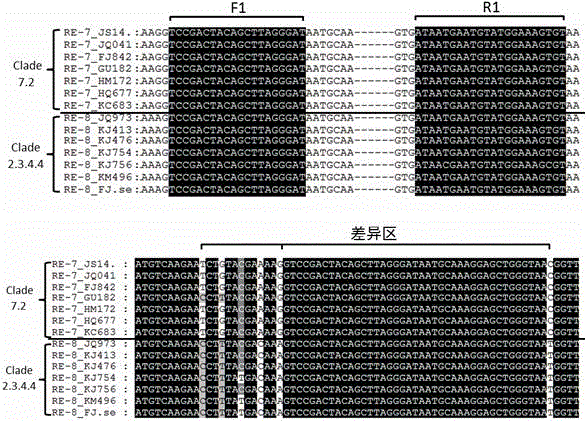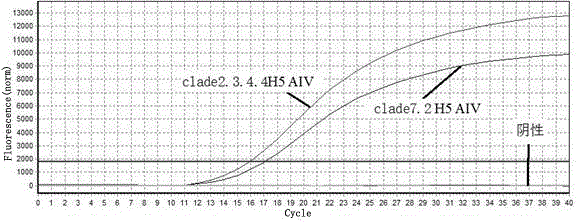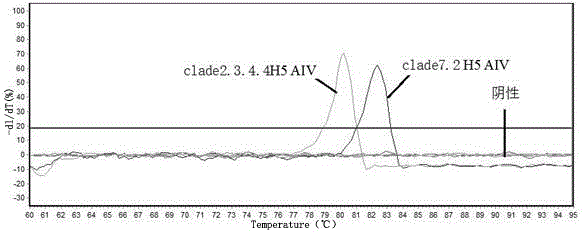Real-time fluorescent quantitative PCR (Polymerase Chain Reaction) primers for distinguishing clade 7.2 type H5 AIV (H5 Subtype Avian Influenza Virus) from clade 2.3.4.4 type H5 AIV
A technology of real-time fluorescence quantification and primer sequence, which is applied in the field of animal epidemiology to achieve the effect of simple identification method, high efficiency and accuracy
- Summary
- Abstract
- Description
- Claims
- Application Information
AI Technical Summary
Problems solved by technology
Method used
Image
Examples
Embodiment 1
[0036] 1. Virus strains:
[0037] H5 subtype influenza virus clade 7.2 branch (DK7 strain) and clade 2.3.4.4 branch (DK10 strain) were both preserved by the Institute of Animal Husbandry and Veterinary Medicine, Fujian Academy of Agricultural Sciences.
[0038] 2. Primer design and synthesis
[0039] The primers F1 and R1 of the real-time fluorescent quantitative PCR reaction were designed according to the characteristic difference region of the hemagglutinin gene HA nucleotides of clade 7.2 and clade 2.3.4.4 H5 AIV, wherein the sequences of the F1 and R1 primers were:
[0040] Upstream primer F1: 5'- TCCGACTACAGCTTAGGGAT -3',
[0041] Downstream primer R1: 5'- ACACTTTCCATACATTCATTATC -3'.
[0042] 3. Viral RNA extraction and RT-PCR amplification:
[0043] Viral RNAs of H5 subtype influenza virus clade 7.2 (strain DK7) and clade 2.3.4.4 (strain DK10) were extracted by conventional methods. Using specific primers (H5-HAF: 5'-TGGTTACCATGCAAACAAC-3' and H5-HAR: 5'- TTACACTTTC...
Embodiment 2
[0054] Real-time fluorescent quantitative PCR detection was carried out on 69 dead duck disease materials submitted for clinical inspection, and it was found that 2 strains were positive for clade 7.2H5 AIV infection, and the positive rate was 2.89% (2 / 69); clade 2.3.4.4 H5 AIV Three strains were positive for infection, and the positive rate was 4.34% (3 / 69); co-infection of clade 7.2 and clade 2.3.4.4H5 AIV was not detected in 69 dead ducks submitted for clinical inspection.
PUM
 Login to View More
Login to View More Abstract
Description
Claims
Application Information
 Login to View More
Login to View More - R&D
- Intellectual Property
- Life Sciences
- Materials
- Tech Scout
- Unparalleled Data Quality
- Higher Quality Content
- 60% Fewer Hallucinations
Browse by: Latest US Patents, China's latest patents, Technical Efficacy Thesaurus, Application Domain, Technology Topic, Popular Technical Reports.
© 2025 PatSnap. All rights reserved.Legal|Privacy policy|Modern Slavery Act Transparency Statement|Sitemap|About US| Contact US: help@patsnap.com



